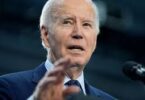Kerry Boyd Anderson
The Biden administration recently released a report that expresses its view of the 2021 US withdrawal from Afghanistan and the evacuation from Kabul. The report identifies some lessons learned but mostly blames the Trump administration, prompting a debate in political circles about whether the White House is failing to acknowledge its own mistakes.
The White House released the report on April 6, preceded by a press conference with National Security Council spokesperson John Kirby. The document draws from internal reviews by the State Department and Defense Department, combined with interagency discussions and work by the National Security Council. The State and Defense Department reviews appear likely to remain classified, though they were recently provided to some congressional committees. The public report represents the White House’s assessment of the several months leading to the August 2021 withdrawal. There is also an Afghan War Commission tasked with reviewing the entire 20 years of the war.
Any review of the Biden administration’s management of the withdrawal eight months after Joe Biden became president must consider what he inherited from the Trump administration. In February 2020, US and Taliban negotiators agreed to a temporary ceasefire, the withdrawal of all US forces by May 2021, the release of thousands of Taliban prisoners and Taliban guarantees not to allow terrorist groups to use Afghan territory to attack the US. Crucially, the Afghan government was not included in the agreement. President Donald Trump began to scale down the US troop presence. When Trump took office in 2017, the US had more than 8,000 to more than 10,000 troops in Afghanistan, depending on the source; when Biden took office, there were only 2,500. The Biden team’s report argues that the Taliban were very likely to resume attacks on US forces if the US did not meet the withdrawal date of May 1. Some critics have noted that Biden was able to delay the withdrawal until the end of August, suggesting that he had some room to maneuver. Critics have also pointed out that the Taliban had already violated the terms of the Doha Agreement, so Biden could have pulled out of it.
However, as the White House report states, with only 2,500 troops left in the country, pulling out of the deal with the Taliban would have placed those troops in danger and required significantly increasing the number of US forces in the country. With widespread support for ending the US’ role in the war and little indication that a surge in forces would change the final outcome, Biden opted to proceed with withdrawal on a slightly extended timeline. The report also blames the Trump administration for failing to leave any plans for withdrawing the remaining troops and evacuating Americans and allies, despite the looming deadline. There is publicly available evidence to suggest that this is a fair criticism of the Trump administration.
The terrible images of desperate Afghans trying to flee Kabul forms another key criticism: that Biden failed to sufficiently help Afghan allies. However, the Trump administration had four years to ramp up the process to provide Special Immigrant Visas or other options for the US’ Afghan allies; instead, it slowed the process and degraded much of the system designed to review, process and assist such refugees. By the end of the Trump administration, there was a “backlog of over 18,000 SIV applicants,” according to the report. Upon entering office, Biden’s team worked quickly to rebuild the system and speed up the processes. Still, the Special Immigrant Visas backlog under Trump was well known before Biden took office and the Biden administration could have acted faster to evacuate Afghan allies.
It is fair to place much of the blame on the Trump administration, which had four years to prepare, while Biden had only a few months. Additionally, there are always constraints on policy; for example, the report highlights the difficulty balancing the need to urge Americans to leave Afghanistan with concerns about undermining the Afghan government’s stability. Nonetheless, there are reasonable criticisms to make of the Biden administration and its report. One fundamental error was assuming that the Taliban would not capture Kabul until sometime after the US military withdrawal. The report says that US intelligence assessments suggested that Kabul would hold against the Taliban for weeks to a couple of years and the Biden administration assumed there would be more time to assist Americans and Afghan allies.
No one can predict the future and intelligence assessments tend to be cautious analytical documents. However, the quick fall of Kabul should not have been such a surprise. Multiple potential sources on the ground – including US government employees, journalists and aid workers – knew that the Afghan forces might fall apart quickly. Also, administrations trying to justify mistakes often point to inaccurate “intelligence assessments,” but there are often differing opinions within those assessments that were ignored. Given the lessons learned from the Iraq war, there is no excuse to ignore or belittle warnings from people familiar with the situation on the ground. In today’s Washington, with extensive resources available for conducting all types of scenarios, there is no excuse for failing to conduct sufficient worst-case scenario exercises or red team reviews of analysis. The Biden administration inherited a mess regarding Afghanistan. There were no good options and it could have been worse. The withdrawal’s failures should not be compared to some idealistic vision of a perfect outcome. At the same time, the Biden administration should have been more prepared for a quick collapse.







